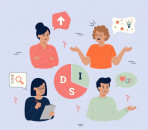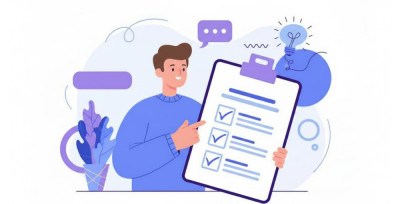Online Communication Style Test (DISC Model)
New Updates



Take Communication Style Test
Get StartedFind Out How You Communicate Best With DISC Personality Test
Behavioral science offers a practical lens for understanding how people prefer to act, decide, and communicate across different contexts. Built on decades of research in temperament and observable behavior, the DISC framework translates complex tendencies into a simple, memorable model. By grouping traits into four primary patterns Dominance, Influence, Steadiness, and Conscientiousness it provides a shared vocabulary that teams and leaders can apply immediately without heavy jargon or clinical barriers.
Across industries, professionals reference the disc test to clarify how natural preferences show up under pressure, in meetings, and while collaborating across roles. Rather than labeling people, the model highlights situational strengths and blind spots, encouraging adaptive strategies that fit the task at hand. In many organizations, the disc model personality test becomes a common language for feedback conversations, performance reviews, and conflict de-escalation. When clarity is needed about how messages land, practitioners sometimes position the tool as a practical communication style test that reduces misinterpretation and builds rapport.
Importantly, the framework is descriptive, not predictive; it reveals what is likely, not what is absolute. That means personal growth remains fully attainable, with the model acting like a map rather than a mandate. With mindful application, users avoid stereotyping and instead focus on context, appreciating how roles, culture, and goals influence behaviors over time.

How the Assessment Works and What the Results Reveal
Most instruments present statements that respondents rank or select, creating a snapshot of observable preferences. Outputs typically include a primary style, possible sub-factors, and narrative insights. For clarity and onboarding, coaches often walk through the essentials, then discuss real workplace scenarios to connect insights to action swiftly.
To interpret outcomes responsibly, facilitators emphasize that a disc assessment test is a starting point for reflection rather than a definitive diagnosis. After scoring, you’ll see graphs or profiles that chart intensity levels across the four dimensions, which helps translate abstract tendencies into practical strategies. For example, a high Dominance score may suggest directness and decisiveness, whereas a high Steadiness score may highlight patience and consistency.
| Style | Core Strengths | Best-Fit Environments |
| Dominance (D) | Decisive, goal-focused, challenge-ready | Fast-paced settings with clear authority and autonomy |
| Influence (I) | Persuasive, enthusiastic, people-oriented | Collaborative spaces with visibility and social interaction |
| Steadiness (S) | Supportive, patient, reliable | Stable teams with predictable rhythms and trust |
| Conscientiousness (C) | Accurate, analytical, quality-driven | Structured roles with high standards and clear rules |
When comparing patterns, practitioners often pair the narrative profile with a focused debrief to ensure nuanced interpretation. In many cases, teams layer a disc analysis test with situational exercises that surface real communication frictions and decision bottlenecks. If you’re new to the space, some providers offer a free disc personality test sample to help you experience the format before committing to a full program, which can be helpful for small teams piloting the approach.
Ultimately, the most value arises when insights are translated into commitments such as altering meeting norms, refining handoffs, and clarifying expectations so the model becomes a catalyst for measurable improvements.
Practical Benefits for Teams, Leaders, and Careers
Organizations turn to behavioral tools to boost clarity, productivity, and trust, especially during periods of change. When teammates understand how to approach each other effectively, friction decreases and progress accelerates. A structured debrief helps people identify when to lean into strengths and when to actively adapt, reducing rework and misalignment.
For leadership development, an applied workshop may highlight how a disc leadership test distills default tendencies under stress and in coaching conversations. Talent teams then align action plans like feedback cadences, role design, and delegation practices with the behavior data to improve outcomes. In hiring and mobility, a balanced approach uses the model as one data point among many, not as a gatekeeper or single determinant.
- Sharper collaboration through shared language and explicit norms
- Faster decision cycles with clearer ownership and escalation paths
- Better stakeholder management via audience-aware messaging
- Reduced conflict by framing differences as complementary strengths
- Resilient culture built on empathy, transparency, and accountability

From an L&D perspective, internal coaches often combine a disc personality assessment test with goal setting and habit tracking to convert insight into behavior change. For role alignment and onboarding, a simple comparison against team norms can guide expectations after a disc profile test debrief, helping new hires integrate smoothly. Over time, organizations that codify these practices see gains in engagement, retention, and cross-functional execution.
How to Take the Test, Accuracy Tips, and Ethical Use
Getting started is straightforward, and most instruments can be completed in under 20 minutes. Quiet settings and honest, instinctive responses typically yield the most accurate readings. It’s useful to think about your default behaviors, not how you wish you acted in an ideal scenario.
For convenience, many providers host a disc test online that delivers immediate results and visual summaries alongside practical guidance. Teams piloting the approach may start with a free disc assessment test to gauge fit, then scale to enterprise-grade versions that add benchmarking and team analytics. In more comprehensive rollouts, consultants sometimes include disc personality profile testing inside broader change initiatives so the data informs communications plans, meeting rituals, and performance frameworks.
- Choose reputable providers with clear methodology and validation notes
- Answer quickly and honestly to capture natural tendencies
- Avoid overinterpreting small score differences; focus on patterns
- Debrief with a coach or trained facilitator to personalize insights
- Revisit results when roles or contexts change to refresh strategies
Ethically, treat outputs as confidential, respect privacy, and ensure voluntary participation. Combine results with skills data and performance evidence to avoid simplistic conclusions. Above all, use insights to enable growth rather than to constrain opportunity.
Take Communication Style Test
Get StartedFrequently Asked Questions
-
What does DISC measure in practical terms?
The instrument summarizes how people prefer to approach problems, interact with others, pace their work, and follow rules or standards. Its power lies in turning these preferences into actionable behaviors that teammates can recognize and adapt to in real time. For those exploring options, some platforms bundle a DISC personality test free trial with introductory guides so readers can experience sample reports before choosing a provider.
-
Is there a way to try it without paying?
Many vendors provide limited versions or pilots to showcase the experience, often with fewer report pages and minimal coaching support. If you’re evaluating tools for a small team, you may encounter offers that include a DISC test for free as part of a short-term promotion or learning series, which can be useful for comparison.
-
How does team debriefing improve outcomes?
Shared interpretation sessions help people translate graphs into practical norms, such as how to structure agendas or deliver feedback. During these conversations, facilitators sometimes complement individual results with a brief DISC profile testing overview so everyone sees how styles interact across the group.
-
Can the results change over time?
Significant life events, new responsibilities, and evolving cultures can shift how preferences show up in daily behavior. Retesting after major role changes or organizational transitions helps ensure your strategies remain calibrated to the current context.
-
Is DISC appropriate for hiring decisions?
Used ethically, the tool informs discussion about work style, collaboration, and role fit, but it should never be a sole gatekeeper. Combining behavior insights with structured interviews, skills verification, and job-relevant simulations creates a more equitable and predictive selection process.
 The Ultimate Guide to Evidence‑Based Communication Testing
The Ultimate Guide to Evidence‑Based Communication Testing